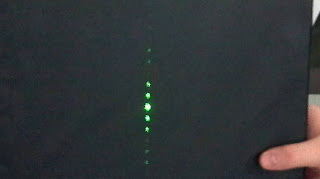1. Describe your observation of the common liquid in which he started his talk.
He talked about how milk is made up of the small fat cells which move around and can attach to eat other making it curdle.
2. Dr. Ray explain two ways in which keep small particles from sticking to themselves and aggregating in to large masses. He explained that the surface area of these particles is important to maintain to feel the benefits of the nanosize. Explain those two methods that he described.
Charge Stabilization - a colloid can only attract so many layers of ions before there is no attraction.
Steric Stabilization - by using certain polymers, you can prevent certain particles from attaching to one another.
Nano Fall 2011
Tuesday, December 20, 2011
Blog Post 15: Dr. Asthana Presentation
1. What are grains and grain boundaries in a material? I suggest you focus on metals. Explain how material properties are affected by the size of these grains.
Grain boundaries in metals are the alignment of atoms in the material when it is produced. These boundaries effect the brittleness and firmness of the material.
2. How does one engineer or process materials to reduce the grain size? In particular, I would like for you to explore and then explain how single crystal silicon is produced for the solar industry.
By heating the materials to a very high temperature and cooling them quickly one can lower the grain size. Crystal silicon is melted and held below 1417C and a single crystal seed starts to grow then cooled.
Grain boundaries in metals are the alignment of atoms in the material when it is produced. These boundaries effect the brittleness and firmness of the material.
2. How does one engineer or process materials to reduce the grain size? In particular, I would like for you to explore and then explain how single crystal silicon is produced for the solar industry.
By heating the materials to a very high temperature and cooling them quickly one can lower the grain size. Crystal silicon is melted and held below 1417C and a single crystal seed starts to grow then cooled.
Blog Post 13: Nano and Proteins
1. Post a brief description (and link) to a general overview of MALDI.
Matrix-assisted laser desorption/ionization is a soft ionization technique used in mass spectrometry. Can be used to allow rapid sequencing of proteins and is crucial now for protein analysis.
http://www.sigmaaldrich.com/analytical-chromatography/spectroscopy/maldi-mass.html
2. Post an image (3D) of the following proteins: microcystin LR, collagen, and pick another one of your favorite proteins.
3. Post the size of each of these proteins in nanometers.
microcystin LR : 200 - 300 nm
collagen : 300 nm
myosin : 10nm step size
4. Research and post a cool nano-application that involves proteins.
Growing cells in the eye to make better measurements inside the eye.
http://www.nanotech-now.com/news.cgi?story_id=44142
Matrix-assisted laser desorption/ionization is a soft ionization technique used in mass spectrometry. Can be used to allow rapid sequencing of proteins and is crucial now for protein analysis.
http://www.sigmaaldrich.com/analytical-chromatography/spectroscopy/maldi-mass.html
2. Post an image (3D) of the following proteins: microcystin LR, collagen, and pick another one of your favorite proteins.
3. Post the size of each of these proteins in nanometers.
microcystin LR : 200 - 300 nm
collagen : 300 nm
myosin : 10nm step size
4. Research and post a cool nano-application that involves proteins.
Growing cells in the eye to make better measurements inside the eye.
http://www.nanotech-now.com/news.cgi?story_id=44142
Blog Post 9: Intro to Invention Project
I will be working with Thomas Trostle and Steve O'Brien.
We want to do something computer based like faster processing, better cooling using carbon nanotubes, or water proofing of components.
We want to do something computer based like faster processing, better cooling using carbon nanotubes, or water proofing of components.
Tuesday, November 8, 2011
Blog Post 11: Invention Team/Timeline
I will be working with Thomas Trostle and Steve O'Brien on the invention project.
Friday, October 14, 2011
Blog Post 7: Diffraction Experiment with Simulation
| The numbers on this image correspond to the positions | |
| Position 1 The distance between line patterns for green = 1 cm, red = 1.25 cm | |
| Position 2 The distance between line patters for green = 1 cm, red = 1.25 cm | |
| Position 3 The distance between line patters for green = 1.5 cm, red = 2 cm | |
| Position 4 The distance between line patters for green = 1.5 cm, red = 2 cm |
Position 1 and 2 are 80nm apart with a thickness of 60nm.
Position 3 and 4 are 120nm apart with a thickness of 60nm.
Subscribe to:
Comments (Atom)






